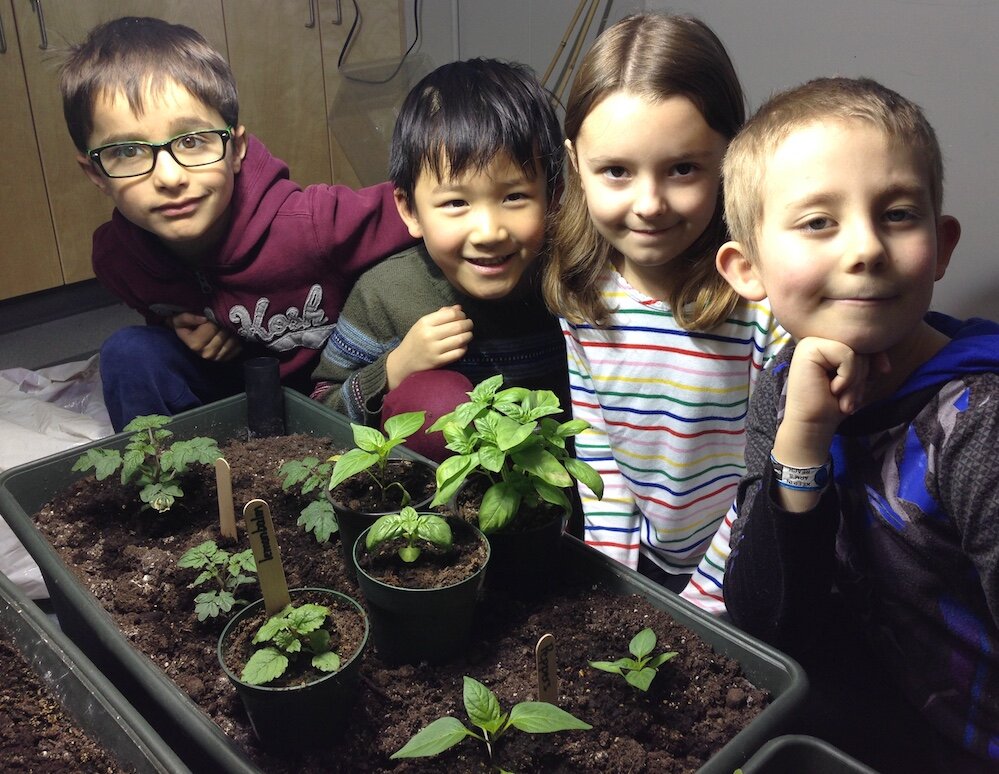Little Green Thumbs gardens offer many learning opportunities across the curriculum. It’s a pleasure to see this in action when we get reports from teachers or have a chance to visit.
At Keheewin School, Grade 4 student Molly told me that her favorite plant is dill and she loved making dill dip with her classmates. Her teacher Ms. Lubert-Wolodko confirmed that the kids were super keen to make a salad with kale, parsley and dill from the garden. “You’d think I was a goddess, they were so excited!” she said. Time and time again, teachers tell us that children love to eat veggies they have grown themselves, which hopefully leads to healthy nutrition choices at home.
The indoor garden is also a great opportunity to communicate verbally and in writing. While at Keheewin School, two students interviewed me skillfully for their school news channel K-TV.
At St. Catherine School, Teacher Ms. Galicia shared the following precious moment: “Our students just finished drawing our plants in their journals. Most of them noticed that snap pea grew faster than cucumber. But 1 snap pea came out so late and 1 student said, ‘Hey! What’s wrong with you? What took you so long? Grow up fast!’”
At Windsor Park and many other schools, the students document the indoor garden’s progress in their journal. The Grade 1 class practices writing, spelling and creating a detailed account of seed and seedling growth. Words like fertilizer and conditioner are not easy for young children but there is meaning and motivation to learn the vocabulary associated with growing plants for food.
Some students are encouraged to pull out a ruler and measure the growth of plants in centimetres, while younger children compare the length of stems, leaves or fruit to the length of their finger. They also use non-standard units to explain change in growth. The Kindergarten class at St. Catherine School did exactly that – the length of a Diva Cucumber was compared to different classroom objects.
At Bessie Nichols School and A. Blair McPherson School, we planted daikon radish and peas with the Grade 4s. These microgreens produce a crop in 10-14 days. The students had many questions about their larger garden and the children were very attentive when planting their seeds. We also placed some basil cuttings in water. In two weeks, the stem of the cuttings developed lots of roots and we transplanted the seedlings into a pot with soil. This science concept from the Grade 4 unit “Plant Growth and Changes” shows how we can plant food from seeds and also “clone” herbs by rooting cuttings in water.
Sometimes the indoor garden can be challenging for a variety of environmental or technical reasons. Therefore, it’s very exciting when the stars align. At Dr. Lila Fahlman School, the plants simply took off. When I visited in February, the kale was beautiful, ready for taste testing. Recently, Ms Mulligan has shared the following comments: “One of the kids counted another 27 pea pods on the vine today! There are 5 cucumbers growing, and the tomato is flowering all over. The kids beg for kale, which I love to hear! We may need to make kale chips though, it's starting to get a bit bitter. But it's all amazing.” It most certainly is!
Claudia Bolli, Little Green Thumbs














